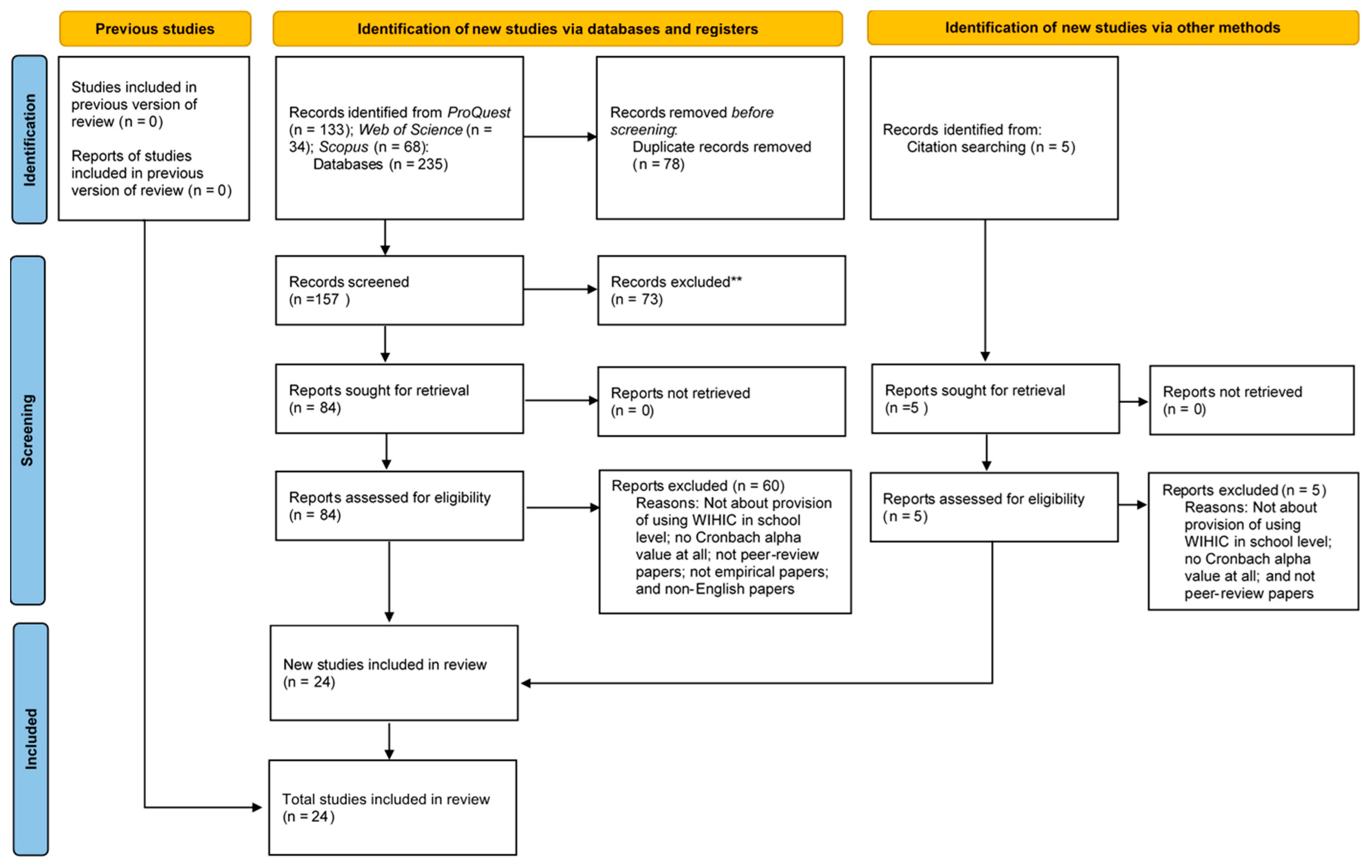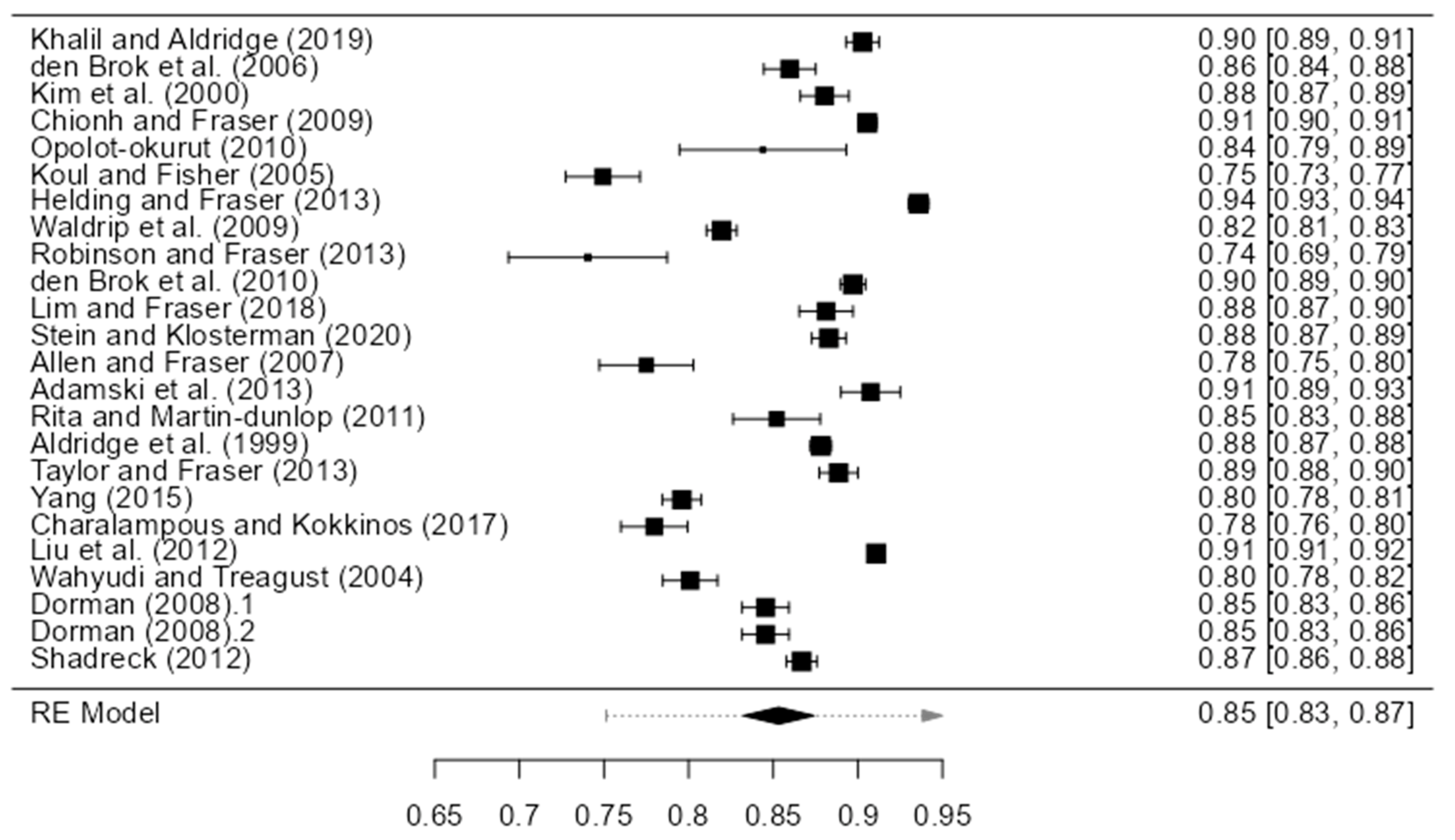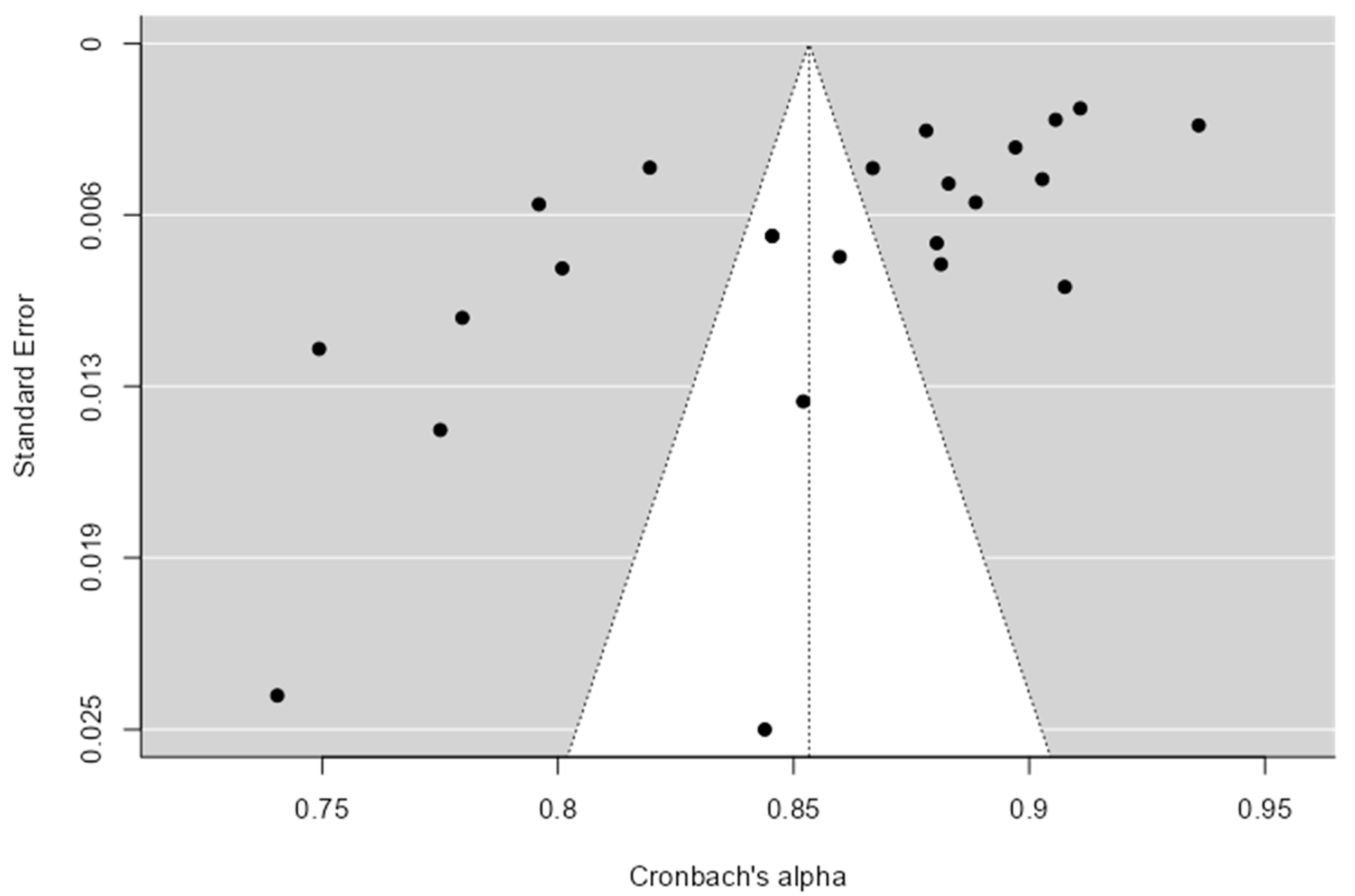A Reliability Generalization Meta-Analysis of “What Is Happening in This Class?” (WIHIC) Questionnaire
Abstract
1. Introduction
2. Materials and Methods
2.1. Data Sources and Literature Search
2.2. Study Selection
2.3. Approach to Analysis and Synthesis
3. Results
3.1. Characteristics of the Included Articles
| Authors | Country | Research Design | Methods | School Context | Translated/Original | Subscales |
|---|---|---|---|---|---|---|
| Adamski et al. [20] | USA | Quantitative | Survey | Mixed | Translated (Spanish) | 6 |
| Aldridge et al. [16] | Taiwan and Australia | Mixed-method | Survey, interviews, observations | Secondary | Translated (Chinese) | 7 |
| Allen and Fraser [25] | USA | Mixed-method | Survey, interviews, observations | Mixed | Original | 6 |
| den Brok et al. [26] | USA | Quantitative | Survey | Secondary | Original | 7 |
| den Brok et al. [22] | Turkey | Quantitative | Survey | Secondary | Translated (Turkish) | 7 |
| Charalampous and Kokkinos [27] | Africa | Mixed-method | Survey, interview | Primary | Original | 7 |
| Chionh and Fraser [28] | Asia | Quantitative | Survey | Secondary | Original | 7 |
| Dorman [29] | Australia | Quantitative | Survey | Secondary | Original | 7 |
| Dorman [30] | Australia | Quantitative | Survey | Secondary | Original | 7 |
| Helding and Fraser [31] | USA | Quantitative | Survey | Secondary | Original | 7 |
| Khalil and Aldridge [21] | Asia | Quantitative | Survey | Secondary | Translated (Arabic) | 5 |
| Kim et al. [23] | Asia | Quantitative | Survey | Secondary | Translated (Korean) | 7 |
| Koul and Fisher [32] | Asia | Quantitative | Survey | Secondary | Original | 7 |
| Lim and Fraser [33] | Asia | Quantitative | Survey | Secondary | Original | 6 |
| Liu et al. [18] | Asia | Mixed-method | Survey, interviews, observations | Secondary | Translated (Chinese) | 5 |
| Opolot-Okurut [34] | Africa | Quantitative | Survey | Secondary | Original | 5 |
| Rita and Mar-tin-Dunlop [35] | USA | Mixed-method | Survey, interview | Secondary | Original | 7 |
| Robinson and Fraser [19] | USA | Quantitative | Survey | Primary | Translated (Spanish) | 5 |
| Shadreck [36] | Africa | Quantitative | Survey | Secondary | Original | 7 |
| Stein and Klosterman [37] | USA | Quantitative | Survey | Secondary | Original | 6 |
| Taylor and Fraser [38] | USA | Quantitative | Survey | Secondary | Original | 7 |
| Wahyudi and Treagust [24] | Asia | Quantitative | Survey | Secondary | Translated (Indonesian) | 7 |
| Waldrip et al. [39] | Australia | Mixed-method | Survey, interview | Secondary | Original | 5 |
| Yang [17] | Asia | Quantitative | Survey | Secondary | Translated (Mandarin) | 7 |
3.2. Reliability and Heterogeneity
3.3. Analysis of Moderator Variables
4. Discussion and Conclusions
Author Contributions
Funding
Institutional Review Board Statement
Informed Consent Statement
Data Availability Statement
Conflicts of Interest
References
- Zandvliet, D.; Fraser, B. (Eds.) Thirty Years of Learning Environments: Looking Back and Looking Forward; Brill Sense: Leiden, The Netherlands, 2019. [Google Scholar]
- Khine, M.S.; Fraser, B.J.; Afari, E. Structural relationships between learning environments and students’ non-cognitive outcomes: Secondary analysis of PISA data. Learn. Environ. Res. 2020, 23, 395–412. [Google Scholar] [CrossRef]
- Cayubit, R.F.O. Why learning environment matters? An analysis on how the learning environment influences the academic motivation, learning strategies and engagement of college students. Learn. Environ. Res. 2022, 25, 581–599. [Google Scholar] [CrossRef]
- Walberg, H.J.; Anderson, G.J. The Achievement-Creativity Dimension and Classroom Climate*. J. Creat. Behav. 1968, 2, 281–291. [Google Scholar] [CrossRef]
- Khine, M.S.; Fisher, D.L. Teacher-student interactions in science classrooms. J. Classr. Interact. 2003, 38, 21–28. [Google Scholar]
- Fraser, B.J.; Lee, S.S.U. Science laboratory classroom environments in Korean high schools. Learn. Environ. Res. 2009, 12, 67–84. [Google Scholar] [CrossRef]
- Fraser, B.J.; Fisher, D.L.; McRobbie, C.J. Development, validation, and use of personal and class forms of a new classroom environment instrument. In Proceedings of the Annual Meeting of the American Educational Research Association, New York, NY, USA, 8–12 April 1996. [Google Scholar]
- Khine, M.S.; Fraser, B.J.; Afari, E.; Oo, Z.; Kyaw, T.T. Students’ perceptions of the learning environment in tertiary science classrooms in Myanmar. Learn. Environ. Res. 2018, 21, 135–152. [Google Scholar] [CrossRef]
- Long, C.S.; Sinclair, B.B.; Fraser, B.J.; Larson, T.R.; Harrell, P.E. Preservice teachers’ perceptions of learning environments before and after pandemic-related course disruption. Learn. Environ. Res. 2022, 25, 343–357. [Google Scholar] [CrossRef]
- Keramati, M.R.; Gillies, R.M. Perceptions of nursing students on the effect of cooperative learning on academic achievement and learning environment. Interact. Learn. Environ. 2022, 14, 1–11. [Google Scholar] [CrossRef]
- Cai, J.; Wen, Q.; Lombaerts, K.; Jaime, I.; Cai, L. Assessing students’ perceptions about classroom learning environments: The New What Is Happening in this Class (NWIHIC) instrument. Learn. Environ. Res. 2022, 25, 601–618. [Google Scholar] [CrossRef]
- Bizimana, E.; Mutangana, D.; Mwesigye, A. Students’ perceptions of the classroom learning environment and engagement in cooperative mastery learning-based biology classroom instruction. Educ. Res. Int. 2022, 2022, 1–14. [Google Scholar] [CrossRef]
- Brandisauskiene, A.; Buksnyte-Marmiene, L.; Cesnaviciene, J.; Daugirdiene, A.; Kemeryte-Ivanauskiene, E.; Nedzinskaite-Maciuniene, R. Sustainable school environment as a landscape for secondary school students’ engagement in learning. Sustainability 2021, 13, 11714. [Google Scholar] [CrossRef]
- Vacha-Haase, T. Reliability Generalization: Exploring variance in measurement error affecting score reliability across studies. Educ. Psychol. Meas. 1998, 58, 6. [Google Scholar] [CrossRef]
- Page, M.J.; McKenzie, J.E.; Bossuyt, P.M.; Boutron, I.; Hoffmann, T.C.; Mulrow, C.D.; Shamseer, L.; Tetzlaff, J.M.; Akl, E.A.; Brennan, S.E.; et al. The PRISMA 2020 statement: An updated guideline for reporting systematic reviews. Int. J. Surg. 2021, 88, 105906. [Google Scholar] [CrossRef] [PubMed]
- Aldridge, J.M.; Fraser, B.J.; Huang, T.C.I. Investigating classroom environments in Taiwan and Australia with multiple research methods. J. Educ. Res. 1999, 93, 48–62. [Google Scholar] [CrossRef]
- Yang, X. Rural junior secondary school students’ perceptions of classroom learning environments and their attitude and achievement in mathematics in West China. Learn. Environ. Res. 2015, 18, 249–266. [Google Scholar] [CrossRef]
- Liu, C.J.; Zandvliet, D.B.; Hou, I.L. The learning environment associated with information technology education in Taiwan: Combining psychosocial and physical aspects. Learn. Environ. Res. 2012, 15, 379–402. [Google Scholar] [CrossRef]
- Robinson, E.; Fraser, B.J. Kindergarten students’ and parents’ perceptions of science classroom environments: Achievement and attitudes. Learn. Environ. Res. 2013, 16, 151–167. [Google Scholar] [CrossRef]
- Adamski, A.; Fraser, B.J.; Peiro, M.M. Parental involvement in schooling, classroom environment and student outcomes. Learn. Environ. Res. 2013, 16, 315–328. [Google Scholar] [CrossRef]
- Khalil, N.; Aldridge, J. Assessing students’ perceptions of their learning environment in science classes in the United Arab Emirates. Learn. Environ. Res. 2019, 22, 365–386. [Google Scholar] [CrossRef]
- den Brok, P.; Telli, S.; Cakiroglu, J.; Taconis, R.; Tekkaya, C. Learning environment profiles of Turkish secondary biology classrooms. Learn. Environ. Res. 2010, 13, 187–204. [Google Scholar] [CrossRef][Green Version]
- Kim, H.B.; Fisher, D.L.; Fraser, B.J. Classroom environment and teacher interpersonal behaviour in secondary science classes in Korea. Eval. Res. Educ. 2000, 14, 3–22. [Google Scholar] [CrossRef]
- Wahyudi; Treagust, D.F. The status of science classroom learning environments in Indonesian lower secondary schools. Learn. Environ. Res. 2004, 7, 43–63. [Google Scholar] [CrossRef]
- Allen, D.; Fraser, B.J. Parent and student perceptions of classroom learning environment and its association with student outcomes. Learn. Environ. Res. 2007, 10, 67–82. [Google Scholar] [CrossRef]
- den Brok, P.; Fisher, D.; Rickards, T.; Bull, E. Californian science students’ perceptions of their classroom learning environments. Educ. Res. Eval. 2006, 12, 3–25. [Google Scholar] [CrossRef]
- Charalampous, K.; Kokkinos, C.M. The Greek elementary “What Is Happening in this Class?” (G-EWIHIC): A three-phase multi-sample mixed-methods study. Stud. Educ. Eval. 2017, 52, 55–70. [Google Scholar] [CrossRef]
- Chionh, Y.H.; Fraser, B.J. Classroom environment, achievement, attitudes and self-esteem in geography and mathematics in Singapore. Int. Res. Geogr. Environ. Educ. 2009, 18, 29–44. [Google Scholar] [CrossRef]
- Dorman, J.P. Use of multitrait-multimethod modelling to validate actual and preferred forms of the What Is Happening in this Class? (WIHIC) questionnaire. Learn. Environ. Res. 2008, 11, 179–193. [Google Scholar] [CrossRef]
- Dorman, J.P. Using student perceptions to compare actual and preferred classroom environment in Queensland schools. Educ. Stud. 2008, 34, 299–308. [Google Scholar] [CrossRef]
- Helding, K.A.; Fraser, B.J. Effectiveness of National Board Certified (NBC) teachers in terms of classroom environment, attitudes and achievement among secondary science students. Learn. Environ. Res. 2013, 16, 1–21. [Google Scholar] [CrossRef]
- Koul, R.B.; Fisher, D.L. Cultural background and students’ perceptions of science classroom learning environment and teacher interpersonal behaviour in Jammu, India. Learn. Environ. Res. 2005, 8, 195–211. [Google Scholar] [CrossRef]
- Lim, C.T.D.; Fraser, B.J. Learning environments research in English classrooms. Learn. Environ. Res. 2018, 21, 433–449. [Google Scholar] [CrossRef]
- Opolot-Okurut, C. Classroom learning environment and motivation towards mathematics among secondary school students in Uganda. Learn. Environ. Res. 2010, 13, 267–277. [Google Scholar] [CrossRef]
- Rita, R.D.; Martin-Dunlop, C.S. Perceptions of the learning environment and associations with cognitive achievement among gifted biology students. Learn. Environ. Res. 2011, 14, 25–38. [Google Scholar] [CrossRef]
- Shadreck, M. Zimbabwean science students’ perceptions of their classroom learning environments and attitude towards science. Mediterr. J. Soc. Sci. 2012, 3, 415–425. [Google Scholar] [CrossRef]
- Stein, S.; Klosterman, P. Nature of learning environment in concurrent enrolment mathematics classrooms: A cluster analysis. Learn. Environ. Res. 2020, 23, 217–234. [Google Scholar] [CrossRef]
- Taylor, B.A.; Fraser, B.J. Relationships between learning environment and mathematics anxiety. Learn. Environ. Res. 2013, 16, 297–313. [Google Scholar] [CrossRef]
- Waldrip, B.G.; Fisher, D.L.; Dorman, J. Identifying exemplary science teachers through students’ perceptions of their learning environment. Learn. Environ. Res. 2009, 12, 1–13. [Google Scholar] [CrossRef]
- Crowder, J. How to Use the FISHER Function in Excel for Mac. Available online: https://turbofuture.com/computers/How-to-Use-the-FISHER-Function-in-Excel-For-Mac (accessed on 15 June 2022).
- George, D.; Mallery, P. Using SPSS for Windows Step by Step: A Simple Guide and Reference, 4th ed.; Pearson Education: London, UK, 2003. [Google Scholar]



| Scale | Description | Item |
|---|---|---|
| Student Cohesiveness | Extent to which students are friendly and supportive of each other. | I make friendships among students in this class. |
| Teacher Support | Extent to which the teacher helps, befriends, and is interested in students. | The teacher takes a personal interest in me. |
| Involvement | Extent to which students have attentive interest, participate in class, and are involved with other students in assessing the viability of new ideas. | I discuss ideas in class. |
| Investigation | Extent to which there is emphasis on the skills and of inquiry and their use in problem solving and investigation. | I carry out investigations to test my ideas. |
| Task Orientation | Extent to which it is important to complete planned activities and stay on the subject matter. | Getting a certain amount of work done is important to me. |
| Cooperation | Extent to which students cooperate with each other during activities. | I cooperate with other students when doing assignment work. |
| Equity | Extent to which the teacher treats students equally, including distributing praise, question distribution, and opportunities to be included in discussions. | The teacher gives as much attention to my questions as to other students’ questions. |
| Database | Syntax | Number of Articles |
|---|---|---|
| ProQuest | WIHIC AND “learning environment” | 133 |
| Scopus | TITLE-ABS-KEY (WIHIC) AND TITLE-ABS-KEY (“learning environment”) | 68 |
| Web of Science | WIHIC (all fields) AND “Learning environment” (all fields) | 34 |
| Inclusion | Exclusion | |
|---|---|---|
| Population | School level | Not university or college level |
| Intervention | NA | NA |
| Comparison | NA | NA |
| Outcomes | Reported Cronbach’s alpha level: whether it is the overall alpha or alpha of the subscales for the WIHIC questionnaire | No Cronbach’s alpha value |
| Study Design | All empirical papers | Not review, discussion, or theoretical papers Non-English papers Not peer-review papers |
| Total Scale/Subscale | n | α | LL | UL | Q | I2 |
|---|---|---|---|---|---|---|
| Total Scale | 24 | 0.85 | 0.83 | 0.87 | 1481.074 * | 99.04% |
| Student Cohesiveness | 22 | 0.80 | 0.77 | 0.84 | 4705.848 * | 99.58% |
| Teacher Support | 23 | 0.87 | 0.85 | 0.90 | 1920.505 * | 99.32% |
| Involvement | 24 | 0.85 | 0.82 | 0.87 | 1280.051 * | 99.1% |
| Investigation | 16 | 0.86 | 0.83 | 0.89 | 1914.472 * | 99.4% |
| Task Orientation | 22 | 0.82 | 0.79 | 0.86 | 4439.097 * | 99.55% |
| Cooperation | 22 | 0.86 | 0.84 | 0.89 | 5675.091 * | 99.51% |
| Equity | 22 | 0.88 | 0.86 | 0.91 | 2314.499 * | 99.47% |
Publisher’s Note: MDPI stays neutral with regard to jurisdictional claims in published maps and institutional affiliations. |
© 2022 by the authors. Licensee MDPI, Basel, Switzerland. This article is an open access article distributed under the terms and conditions of the Creative Commons Attribution (CC BY) license (https://creativecommons.org/licenses/by/4.0/).
Share and Cite
Oo, C.Z.; Khine, M.S.; San, N.M.H. A Reliability Generalization Meta-Analysis of “What Is Happening in This Class?” (WIHIC) Questionnaire. Educ. Sci. 2022, 12, 929. https://doi.org/10.3390/educsci12120929
Oo CZ, Khine MS, San NMH. A Reliability Generalization Meta-Analysis of “What Is Happening in This Class?” (WIHIC) Questionnaire. Education Sciences. 2022; 12(12):929. https://doi.org/10.3390/educsci12120929
Chicago/Turabian StyleOo, Cherry Zin, Myint Swe Khine, and Nang Mo Hline San. 2022. "A Reliability Generalization Meta-Analysis of “What Is Happening in This Class?” (WIHIC) Questionnaire" Education Sciences 12, no. 12: 929. https://doi.org/10.3390/educsci12120929
APA StyleOo, C. Z., Khine, M. S., & San, N. M. H. (2022). A Reliability Generalization Meta-Analysis of “What Is Happening in This Class?” (WIHIC) Questionnaire. Education Sciences, 12(12), 929. https://doi.org/10.3390/educsci12120929








